Prince Robert was the first one and I've forgotten the precise
reason for my pier head jump to Prince Robert. I think perhaps it
was because it was to go to sea before it was fully ready because there
were rumours (they turned out to be honest reports) of German ships that
were holed out in South American and in Mexican ports, but at any rate
with a day or two's notice I was appointed to Prince Robert and joined
her in Vancouver while dockyards people were still aboard. While her main
armament, which was four- to six-inch guns, was non-functional, we did
take her to sea for trials and found a great many defects, including unfortunate
ones to do with the guns being not properly functional. Because of the
report of an imminent, or the apparently imminent, departure of a German
ship from one of the Mexican ports on the Pacific, we set sail with an
untried crew, and as I said, with the ship not having [been] worked up
at all, and proceeded to Manzanillo in Southern Mexico and spent the next
three or four weeks going up and down the coast outside the harbour.
In the daytime, we would go out twenty or thirty miles out of sight
of land and at night come in quite close to land within two or three miles
and there was a heavy ground swell at this particular point because of
the continental shelf dropping quite steeply, and the ground swell caused
the ship to rock approximately sixty degrees, which was very disturbing
to all concerned, especially when it went on week after week and we were
of course blacked out at night so that the ship became very unpleasant
down below. On deck was all right except for this persistent rolling.
Well, the reason I'm giving you this long report is that the German ship
in question did come out one night and we captured her and during the succeeding
ten days
escorted her back to Esquimalt. I think this was the first action
resulting in any sort of successful taking of an enemy ship by the Canadian
Navy in World War II.
Capture
of the Weser
The reporting from onshore [Manzanillo] was very good and we received
messages two or three times a day on what was happening to the German ship,
and as I said, we came in every night to within a couple of miles of the
mouth of the harbour, sometimes even closer, and one night a ship did come
out and our search lights were operating satisfactorily I'm glad to say,
and we turned the lights on her and found that she was the German ship
that we had expected and over a loud hailer she was told that if she scuttled
or if she made any sort of evasive action that we would sink her.
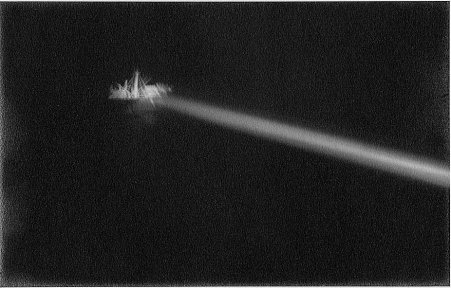
Weser Caught in the Searchlight ~ September 25, 1940
Well, we could have sunk her all right because a couple of our guns
were operational and of course the German ship had been advised that there
was no allied warship within a thousand miles--their advice was wrong--so
they didn't know what to expect except that they were in the glare of a
search light and were advised that they would [be] sunk if they did anything
untoward, so we sent a boarding party on board and there was a little bit
of fighting but rather mild, and as I said before, we took off about thirty
of their crew and had them in a public area of our ship with a machine
gun at the entrance to this open area. Actually the whole thing was
difficult because we were not prepared or really trained to take such an
action at that time but it worked out very well.
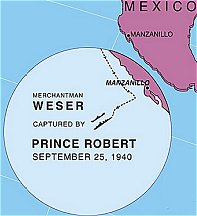 One
of the things that shocked us was, on our way north, to hear of our successful
capture over the NBC news. We reported in cipher that we had captured
the ship and were escorting her to Esquimalt and so the Admiralty in London
and Naval Service headquarters in Ottawa knew very well what had happened,
and we thought that they were extremely unwise to make an announcement
when were at least a thousand miles from Esquimalt and were operating in
a very precarious way . . . our guns wouldn't shoot very well and the ship
was not in good shape at all . . . our crew was really untried, we had
thirty or forty German prisoners aboard our ship and we had a prize crew
aboard the motor ship Weser, which was the name of the German ship, that
we were also had reports of other German raiders in the vicinity -- I think
incorrect reports, but we didn't know it -- and we were very much afraid
that our ship was going to be taken away from us and perhaps our prize
recaptured.
One
of the things that shocked us was, on our way north, to hear of our successful
capture over the NBC news. We reported in cipher that we had captured
the ship and were escorting her to Esquimalt and so the Admiralty in London
and Naval Service headquarters in Ottawa knew very well what had happened,
and we thought that they were extremely unwise to make an announcement
when were at least a thousand miles from Esquimalt and were operating in
a very precarious way . . . our guns wouldn't shoot very well and the ship
was not in good shape at all . . . our crew was really untried, we had
thirty or forty German prisoners aboard our ship and we had a prize crew
aboard the motor ship Weser, which was the name of the German ship, that
we were also had reports of other German raiders in the vicinity -- I think
incorrect reports, but we didn't know it -- and we were very much afraid
that our ship was going to be taken away from us and perhaps our prize
recaptured.
October,
1940 - March 1941
[We returned to] Esquimalt and spent a couple of weeks [while the dockyards
people] tried to make the ventilation more effective and [repair] the distillers
for producing fresh water. One of the troubles that we had while
on our first trip was that there was very little fresh water, but the distillers
weren't operating and the water was somewhat salty that we had available
for drinking, so but this was corrected and after a few weeks [October
9/10, 1940] we set out again and that time spent almost six months at sea.
Our usual procedure was to spend about a day a month in one of the South
American ports like Valpariso or Callao, which is the port of Lima, and
during this twenty-four hour stopover in these ports, of course, we had
a great deal of relaxation of the usual sort done by sailors, but the time
ashore was very short, usually twenty-four hours only at one of the ports.
These were all neutral ports and they didn't allow warships to visit for
more than I think twenty-four hours. We also had a holiday, and our
holiday was an unusual one: because we had been at sea for long periods,
the Admiralty decided that they'd give us a New Years vacation, and our
New Year's vacation was in the Darwin Channel [according to log
of Charles Anderson, New Year's Day was at Port Yates, 41 degrees S,
not far from Puerto Montt] towards the south part of Chile, and it is a
benighted place.
It was foggy and cold and there were no habitations of any note until
you got to the Falkland Islands in this part of South America. There
were some farms on the shore but we were carefully sent to as remote a
place as possible because the Admiralty didn't want to advertise our exact
location. Now one of the interesting mornings that I remember on
our 'vacation' was that going close to shore where there were a few farms
and the people on shore seeing a warship of some sort going a mile or two
off shore were interested and started to cheer and wave their hands, and
we thought this was a very nice welcome from a sparsely settled area. About
a month later when we were in Talcahuano, which is a port a little bit
further north on the coast of Chile, we learned that the residents there
thought that we were a German ship, not a Canadian or British, and the
reason they were cheering was that most of that area had been settled by
the Germans many years before, so they were naturally pleased to see the
Fatherland showing the flag so to speak. But we felt welcomed even
if the welcome was for somebody else.
Well, our vacation was cut short after a day or so of wandering around
this fog-bound coast, and was cut short because we got a signal that one
of the German pocket battleships was believed to be holed out a little
bit further down the coast, so this didn't sound good news to any of us
because, as I said earlier, Prince Robert's guns were almost ineffective
and going down to see the vonScheer [Admiral Scheer?] seemed like a kiss
of death. Now fortunately the report proved to be wrong. We
learned later that she was in the Indian Ocean, but certainly the possibility
of meeting a pocket battleship with an auxiliary cruiser caused some bad
gastrointestinal problems among most of the people on our ship.
Most of the time, as I said, we were on the west coast of South America
and went across to Fiji to escort the New Zealand expeditionary force,
which went from New Zealand to Victoria and then across Canada by train.We
picked up [and escorted] a ship called the Awatea in Suva and from there
went back to Victoria. We were looking forward to meeting the Awatea in
Suva because we'd run out of most of our provisions and it was impossible
to restock very well in the South American ports; but we found to our displeasure
that in Fiji they just had a hurricane and all the chickens and things
like that had been blown away so our looking forward to this promised land
flowing with milk and honey wasn't as quite as satisfactory as we'd hoped.
We also did oil at sea and the oilers that came usually from the Caribbean
through the Canal and then down to wherever we were on the coast of South
America did bring some provisions, but most of these were tinned goods
and things that could be stored well. There was no fresh food at
all except in our infrequent visits to the South American ports, so we
didn't eat very well after the first three or four months.
...As a Medical Officer most of the time was rather boring, but over
six months or so you did pick up a number of patients. The reason
for the relative scarcity of patients is that there were only two hundred
and fifty men in the ship and most of them were young and healthy, so that
it did take a while to build up a hospital practice, but accidents occurred.
We had a few fractures. I remember one very severe case of diabetes
developed apparently secondarily to an infection, and we picked up a fair
bit of venereal disease in spite of the infrequent visits to the South
American ports: our sailors seemed to get around and I was able to diagnose
both gonorrhoea and syphilis... there was also one chap [George Brown,
according
to Charles Anderson's
log] that had a badly fractured skull and I decided that because of
the severity of the fracture that his chances of survival on the ship were
poor so he was landed: the accident happened to occur when we were in Valparaiso,
so he was landed and went to hospital there and subsequently was interned
and later was delivered back to Prince Rupert in a British ship, his whole
circuitous trip taking the better part of the year. The other people
regardless of what happened to them had to confront the difficult problem
of either getting interned if they went ashore in South America, or being
kept in the ship where they probably would eventually get to a British
port or even back to Victoria, so I ended up with half a dozen people in
the sick bay plus a fair number of people who were on light duty, but this
took quite a long time to build up and most of the things weren't too severe
anyway.
About
the Armament of the Prince Robert in 1940-41
. . . the Canadian Navy and Canadian Forces were well organized but
extremely small. They were small in number of people but also very
small in terms of number of ships or in armament, and the guns that I referred
to were [built in] 1897, at least two of them weren't operational--they
could be fired but
one of them couldn't be trained, I remember, so it in effect it wasn't
an effective weapon. Even the side arms that we had were inadequate, there
just weren't enough rifles or machine guns available to take and I remember
that I took my own revolver because there weren't service revolvers for
all the officers. I think there were only half a dozen among the
twenty-five officers in the ship, and I think that the sailors only had
about one rifle per two individuals, but we didn't have any explosive material
that could be used for blowing up or sinking a ship if we wanted to do
it. We did have depth charges of course but the whole thing was very,
very slapdash, and I guess that many of the other ships that went out were
as badly
equipped. We were amateurs and over the better part of the year
we were at sea, the prairie sailors that made up most of the crew turned
into sailors, but to start with there was no question about being professionals
as navies go, we were all amateurs.
Most of the ships we were after were merchant ships so that they probably
were not any better equipped than we were, but there were extremely well-armed
German raiders that were operating in the Indian Ocean, in the South Atlantic,
and occasionally in the South Pacific, and we really were not in a good
position to put up any sort of a fight against them, and I think your comment
we were lucky not to meet them was absolutely right, and of course this
pocket battle ship would be just impossible. You wouldn't even see
a pocket battle ship before it had been able to sink you.
The Prince ships underwent quite a few changes and of course were extremely
well armed in the numbers of changes that they underwent. They gradually
got anti-aircraft guns and the old, old six-inch guns were replaced with
modern 4.7's and they became fighting ships, even though unarmoured, as
time went on, but the first few times they went out they were sitting ducks
if they'd come across any real opposition.
...One of the roles that the auxiliary cruisers, and armed merchant
cruisers did fill was that they could occupy an enemy ship for awhile,
and in convoy duty in the Atlantic the AMC's were sitting ducks to a large
extent against any battleship or cruiser, but they did take up quite a
lot of time so that any ships that they were escorting had an opportunity
to disperse while the enemy ship was occupied with the AMC or auxiliary
cruiser: if you're in one of the escort ships or an AMC it doesn't make
for high morale because it is a fact of life.
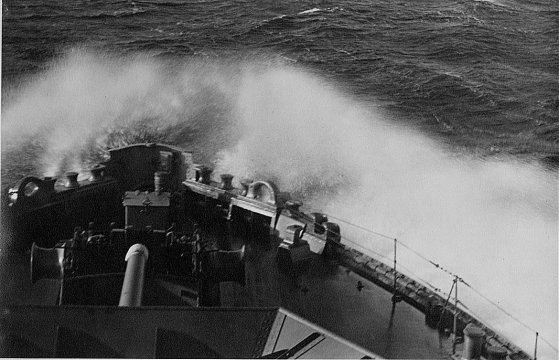
View from the bridge of HMCS Prince Robert
~ Sandy Sellers
Glenburnie, Ontario
Text and Photos© Estate of E. A. Sellers
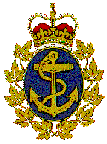

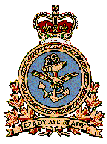
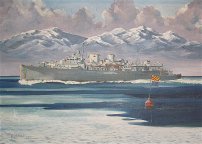
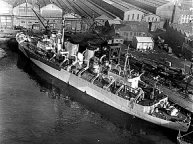
![]() Home
Port
Home
Port
